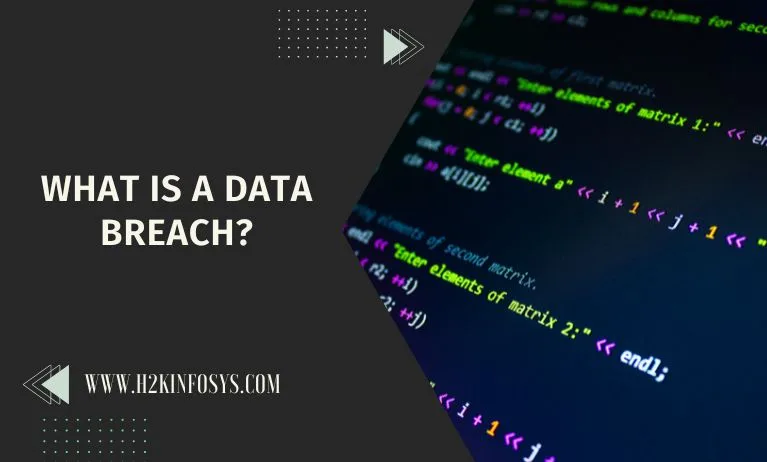Any situation in which someone acquires unauthorised access to private or protected information is considered a data breach. This covers both internal and external data breaches where partners, contractors, or employees copy, view, communicate, or steal information they shouldn’t have access to.
Data breaches can have an impact on both people and businesses. Corporate data breaches may be the consequence of negligent behaviour on the part of an authorised user or intentional mistakes. To learn more about Data Breaches in Cybersecurity, you can check out the online cybersecurity course.
How Data Breaches Happen
There are numerous ways that data breaches can happen. Whether the threat came from within the organisation or from outside is one of the key differentiators.
Internal Threats
It is a common misconception that cybercriminals operating from outside the corporation are responsible for data breaches and other security mishaps. Insiders, though, can also pose a threat to a company and its data.
The network and systems of a business, as well as possibly the sensitive data in concern, are legitimately accessible to trusted insiders. As a result, it is simpler for them to access the protected data and take activities that, whether on purpose or accidentally, expose it to unauthorised users.
For instance, improperly configured cloud infrastructure is a frequent source of data breaches. Insiders may make it easier for unauthorised users to access and utilise business data if they copy it to their personal cloud or alter cloud security settings.
External Threats
Data breaches that come from sources other than the company are more likely to make headlines. A greater concern is raised when sensitive data is compromised, as opposed to when an email is accidentally shared.
Similar assault trajectories are followed by external data breaches and other cyberattacks. These attack chains, as described in the MITRE ATT&CK framework or Lockheed Martin’s Cyber Kill Chain, involve a number of stages that advance the attacker from initial reconnaissance to accessing and exfiltrating the target data.
Sensitive or protected data can be used in a number of ways once it is in the hands of an attacker. On the dark web, data is frequently sold for sale. Some forms of data can be used for fraud or to access user accounts.
Types of Data Breach
There are many various kinds of data breaches. The following are a few of the most typical types of data breaches:
- Employee Error: Data breaches are frequently caused by employee errors. Employees can either directly create a data breach by exposing data via email, cloud infrastructure, etc., or they can facilitate a breach by using faulty login credentials, configuring security settings incorrectly, etc.
- Lost/Stolen Devices: If the data is not encrypted at rest, lost or stolen devices could result in data breaches. Computers, mobile devices, removable media, and more examples are provided.
- Malware: Some varieties are created expressly to steal private data. This comprises malware such as remote access trojans (RATs), credential stealers, and banking trojans that grant the attacker the access they need to steal data.
- Phishing: Phishing emails frequently aim to steal personal information. Phishing attempts may be made to obtain sensitive information from employees, steal user credentials, etc.
- Ransomware: To coerce targets into paying a ransom beyond only blocking access to private or important information, ransomware gangs have broadened the scope of their assaults to include other extortion techniques. The theft of data from a target while making a threat to release it if a ransom is not paid is one example of this.
- Skimming: At a point of sale (POS) device or website, skimmers are used to gather payment card information. Skimmers can be real objects or malicious software incorporated into a website.
- Attacks on web applications: An additional frequent reason for data breaches is the exploitation of online application vulnerabilities. Web application threats that can expose sensitive data include SQL injection and cross-site scripting (XSS).
Data Breach Examples
Data breaches are already widespread and even the most serious ones use a variety of different methods. For instance, a few of the most significant recent data breaches are:
- Colonial Pipeline: The ransomware attack against the pipeline is the most well-known aspect of the Colonial Pipeline breach. A hundred terabytes or more of data were also stolen by the attackers, albeit they threatened to disclose it if the ransom was not paid.
- Facebook: In January 2021, Socialarks, a Chinese social media management business, had a data breach that resulted in the disclosure of the personal data of 214 million Facebook members (408 GB of data).
- Kroger: Over a million HR and pharmaceutical records, including names, phone numbers, addresses, birthdates, Social Security Numbers (SSNs), and medical information, were acquired by the supermarket chain’s attackers. This supply chain hack was made possible by an assault on Accellion, a different cloud service provider.
Conclusion
Data breaches are becoming more frequent, and data protection laws are becoming stronger and enforcing harsher penalties for data leaks. Employing cybersecurity best practices including Access Control, Cybersecurity Awareness Training, Data Encryption, Endpoint Security, and Threat Detection and Prevention will help organizations reduce the risk and expense of a data breach. Check out the online cyber security training to learn more.






























